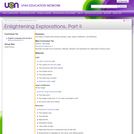
This lesson contains three student activities: Light, Angle of Reflection, and Refraction.
- Subject:
- Arts and Humanities
- Material Type:
- Activity/Lab
- Lesson Plan
- Provider:
- Utah Education Network
- Date Added:
- 08/12/2013

This lesson contains three student activities: Light, Angle of Reflection, and Refraction.
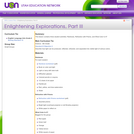
This lesson contains three student activities: Rainbows, Refraction with Prisms, and What Color Is It?

This article aligns the concepts of Essential Principle 2 of the Climate Sciences to the K-5 content standards of the National Science Education Standards. The author also identifies common misconceptions about heat and the greenhouse gases effect and offers resources for assessing students' understanding of interactions among components of the Earth system. This article continues the examination of the climate sciences and climate literacy on which the online magazine Beyond Weather and the Water Cycle is structured.
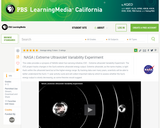
In this NASA video, scientists describe how the Extreme Ultraviolet Variability Experiment will sample and track the Sun's ultraviolet irradiance, providing a detailed time sequence of extreme ultraviolet output -- data that can provide advance warning for potentially disruptive energy bursts.

Students use electricity every day. It is important to know how it works. Why does the light come on when they flip the switch? With a simple knowledge of circuits, students will understand how electrical energy moves from one place to another. Students will provide evidence to describe why the light bulb turned on, including the idea that energy can be transferred from place to place by electrical currents.
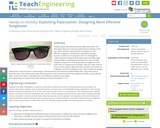
Students apply what they know about light polarization and attenuation (learned in the associated lesson) to design, build, test, refine and then advertise their prototypes for more effective sunglasses. Presented as a hypothetical design scenario, students act as engineers who are challenged to create improved sunglasses that reduce glare and lower light intensity while increasing eye protection from UVA and UVB radiation compared to an existing model of sunglasses—and make them as inexpensive as possible. They use a light meter to measure and compare light intensities through the commercial sunglasses and their prototype lenses. They consider the project requirements and constraints in their designs. They brainstorm and evaluate possible design ideas. They keep track of materials costs. They create and present advertisements to the class that promote the sunglasses benefits, using collected data to justify their claims. A grading rubric and reflection handout are provided.
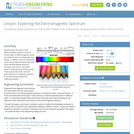
Students learn the basics of the electromagnetic spectrum and how various types of electromagnetic waves are related in terms of wavelength and energy. In addition, they are introduced to the various types of waves that make up the electromagnetic spectrum including, radio waves, ultraviolet waves, visible light and infrared waves. These topics help inform students before they turn to designing solutions to an overarching engineering challenge question.
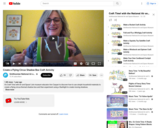
Discover how to use simple household materials to create a shadow box and learn about shadows and light.
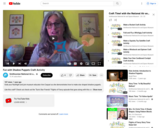
Grab your flashlight and join museum educator Ann Caspari as she demonstrates how to make sun and star shaped shadow puppets
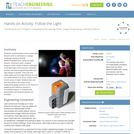
Students' understanding of how robotic light sensors work is reinforced in a design challenge involving LEGO MINDSTORMS(TM) NXT robots and light sensors. Working in pairs, students program LEGO robots to follow a flashlight as its light beam moves around. Students practice and learn programming skills and logic design in parallel. They see how robots take input from light sensors and use it to make decisions to move, similar to the human sense of sight. Students also see how they perform the steps of the engineering design process in the course of designing and testing to achieve a successful program. A PowerPoint® presentation and pre/post quizzes are provided.
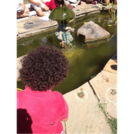
Students will explore the garden for different forms of energy including mechanical, electrical, light, thermal and sound energy.
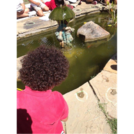
STUDENT ACTIVITY -- 4th -- TXThis is a distance-learning lesson students can complete at home.The student will explore their outdoor space for different forms of energy including mechanical, electrical, light, thermal and sound energy.This activity was created by Out Teach (out-teach.org), a nonprofit providing outdoor experiential learning to transform Science education for students in under-served communities.
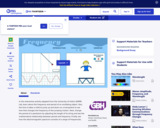
In this interactive activity adapted from the University of Utah's ASPIRE Lab, investigate frequency in terms of trampoline jumps, pendulum swings, and electromagnetic waves.

This video lesson has the goal of introducing students to galaxies as large collections of gravitationally bound stars. It explores the amount of matter needed for a star to remain bound and then brings in the idea of Dark Matter, a new kind of matter that does not interact with light. It is best if students have had some high school level mechanics, ideally Newton's laws, orbital motion and centripetal force. The teacher guide segment has a derivation of centripetal acceleration. This lesson should be mostly accessible to students with no physics background. The video portion of this lesson runs about 30 minutes, and the questions and demonstrations will give a total activity time of about an hour if the materials are all at hand and the students work quickly. However, 1 1/2 hours is a more comfortable amount of time. There are several demonstrations that can be carried out using string, ten or so balls of a few inches in diameter, a stopwatch or clock with a sweep second hand and some tape. The demonstrations are best done outside, but can also be carried out in a gymnasium or other large room. If the materials or space are not available, there are videos of the demonstrations in the module and these may be used.
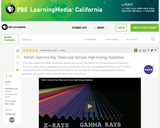
This video from NASA describes the GLAST satellite, which is equipped with a gamma-ray telescope, and shares some background about the kinds of extreme universal phenomena indicated by the presence of gamma rays.
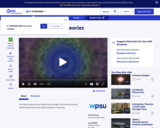
This video segment from Swift: Eyes through Time introduces and explains theories of the origin of gamma-ray bursts.
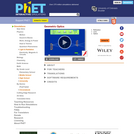
How does a lens form an image? See how light rays are refracted by a lens. Watch how the image changes when you adjust the focal length of the lens, move the object, move the lens, or move the screen.
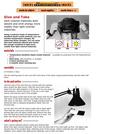
In this activity, learners explore liquid crystals, light and temperature. Using a postcard made of temperature-sensitive liquid crystal material, learners monitor temperature changes. By observing these changes, learners show that dark materials absorb and reemit the energy contained in light more readily than light-colored materials. Learners can also distinguish energy absorbed and reemited by radiation, convection, and conduction by comparing the behavior of black, white, and silver objects. This resource guide includes detailed explanation of the phenomenon and background information about liquid crystals.
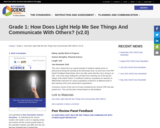
Awarded the NGSS Design Badge
This first-grade unit on light starts with students exploring the shapes they can see on different pieces of paper at various locations around their classroom when the lights are turned off. They are surprised to find that some of the shapes are not visible in these conditions. This leads students to start wondering about other phenomena related to seeing in the dark, which in turn leads to new questions and design problems related to how they can make their room completely dark.
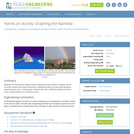
Students are introduced to different ways of displaying visual spectra, including colored "barcode" spectra, like those produced by a diffraction grating, and line plots displaying intensity versus color, or wavelength. Students learn that a diffraction grating acts like a prism, bending light into its component colors.